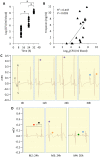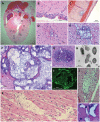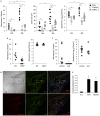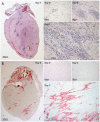Streptococcus pneumoniae translocates into the myocardium and forms unique microlesions that disrupt cardiac function
- PMID: 25232870
- PMCID: PMC4169480
- DOI: 10.1371/journal.ppat.1004383
Streptococcus pneumoniae translocates into the myocardium and forms unique microlesions that disrupt cardiac function
Abstract
Hospitalization of the elderly for invasive pneumococcal disease is frequently accompanied by the occurrence of an adverse cardiac event; these are primarily new or worsened heart failure and cardiac arrhythmia. Herein, we describe previously unrecognized microscopic lesions (microlesions) formed within the myocardium of mice, rhesus macaques, and humans during bacteremic Streptococcus pneumoniae infection. In mice, invasive pneumococcal disease (IPD) severity correlated with levels of serum troponin, a marker for cardiac damage, the development of aberrant cardiac electrophysiology, and the number and size of cardiac microlesions. Microlesions were prominent in the ventricles, vacuolar in appearance with extracellular pneumococci, and remarkable due to the absence of infiltrating immune cells. The pore-forming toxin pneumolysin was required for microlesion formation but Interleukin-1β was not detected at the microlesion site ruling out pneumolysin-mediated pyroptosis as a cause of cell death. Antibiotic treatment resulted in maturing of the lesions over one week with robust immune cell infiltration and collagen deposition suggestive of long-term cardiac scarring. Bacterial translocation into the heart tissue required the pneumococcal adhesin CbpA and the host ligands Laminin receptor (LR) and Platelet-activating factor receptor. Immunization of mice with a fusion construct of CbpA or the LR binding domain of CbpA with the pneumolysin toxoid L460D protected against microlesion formation. We conclude that microlesion formation may contribute to the acute and long-term adverse cardiac events seen in humans with IPD.
Conflict of interest statement
AOB, BM, EIT, and CJO are listed as inventors on patents regarding the use of the synthetic pneumococcal vaccine YLN to prevent invasive pneumococcal disease and cardiac damage. This does not alter our adherence to all PLOS policies on sharing data and materials.
Figures






References
-
- Corrales-Medina VF, Musher DM, Wells GA, Chirinos JA, Chen L, et al. (2012) Cardiac complications in patients with community-acquired pneumonia: incidence, timing, risk factors, and association with short-term mortality. Circulation 125: 773–781. - PubMed
-
- Corrales-Medina VF, Serpa J, Rueda AM, Giordano TP, Bozkurt B, et al. (2009) Acute bacterial pneumonia is associated with the occurrence of acute coronary syndromes. Medicine 88: 154–159. - PubMed
-
- Kaplan V, Clermont G, Griffin MF, Kasal J, Watson RS, et al. (2003) Pneumonia: still the old man's friend? Arch Intern Med 163: 317–323. - PubMed
-
- Kumar S, Wang L, Fan J, Kraft A, Bose ME, et al. (2008) Detection of 11 common viral and bacterial pathogens causing community-acquired pneumonia or sepsis in asymptomatic patients by using a multiplex reverse transcription-PCR assay with manual (enzyme hybridization) or automated (electronic microarray) detection. J Clin Microbiol 46: 3063–3072. - PMC - PubMed
Publication types
MeSH terms
Substances
Grants and funding
- K23 HL096054/HL/NHLBI NIH HHS/United States
- NIH AI27913/AI/NIAID NIH HHS/United States
- P51 RR000164/RR/NCRR NIH HHS/United States
- 5I01BX000505/BX/BLRD VA/United States
- R01 HL075360/HL/NHLBI NIH HHS/United States
- R01 AI027913/AI/NIAID NIH HHS/United States
- R00 AT006704/AT/NCCIH NIH HHS/United States
- UL1 TR001120/TR/NCATS NIH HHS/United States
- NIH AT006704/AT/NCCIH NIH HHS/United States
- K99 AT006704/AT/NCCIH NIH HHS/United States
- I01 BX000505/BX/BLRD VA/United States
- R01 AI078972/AI/NIAID NIH HHS/United States
- N01-HV-00244/HV/NHLBI NIH HHS/United States
- NIH AA009803/AA/NIAAA NIH HHS/United States
- F31 AI104177/AI/NIAID NIH HHS/United States
- KL2 TR001118/TR/NCATS NIH HHS/United States
- HL075360/HL/NHLBI NIH HHS/United States
- HL108054/HL/NHLBI NIH HHS/United States
- R21 HL108054/HL/NHLBI NIH HHS/United States
- NIH HL096054/HL/NHLBI NIH HHS/United States
- RR00164/RR/NCRR NIH HHS/United States
- P50 AA009803/AA/NIAAA NIH HHS/United States
- 268201000036C/PHS HHS/United States
LinkOut - more resources
Full Text Sources
Other Literature Sources
Medical

